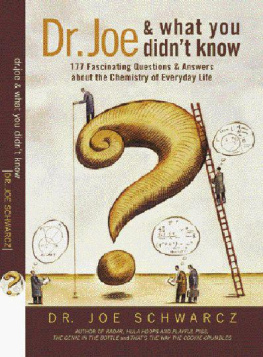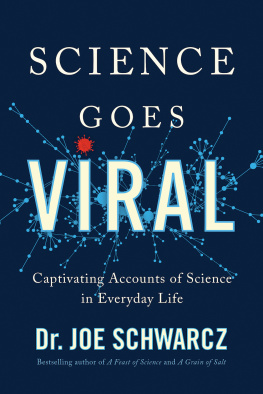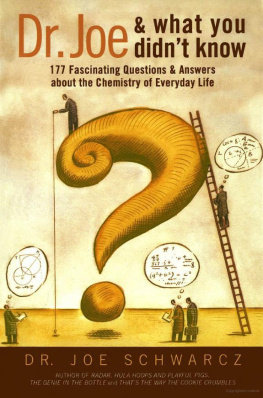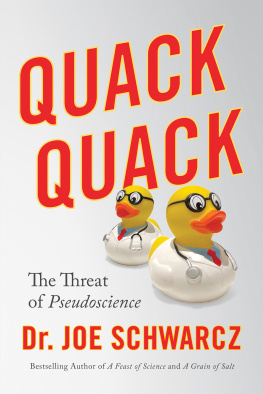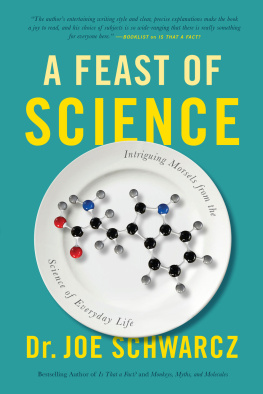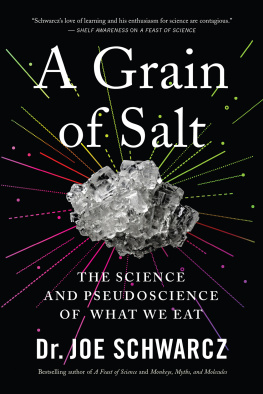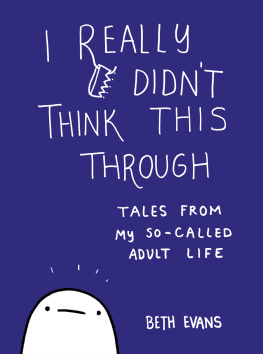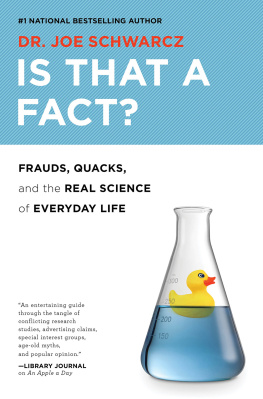Dr. Joe Schwarcz - Dr. Joe and what you didn’t know
Here you can read online Dr. Joe Schwarcz - Dr. Joe and what you didn’t know full text of the book (entire story) in english for free. Download pdf and epub, get meaning, cover and reviews about this ebook. year: 2010, publisher: ECW Press, genre: Art. Description of the work, (preface) as well as reviews are available. Best literature library LitArk.com created for fans of good reading and offers a wide selection of genres:
Romance novel
Science fiction
Adventure
Detective
Science
History
Home and family
Prose
Art
Politics
Computer
Non-fiction
Religion
Business
Children
Humor
Choose a favorite category and find really read worthwhile books. Enjoy immersion in the world of imagination, feel the emotions of the characters or learn something new for yourself, make an fascinating discovery.
- Book:Dr. Joe and what you didn’t know
- Author:
- Publisher:ECW Press
- Genre:
- Year:2010
- Rating:3 / 5
- Favourites:Add to favourites
- Your mark:
- 60
- 1
- 2
- 3
- 4
- 5
Dr. Joe and what you didn’t know: summary, description and annotation
We offer to read an annotation, description, summary or preface (depends on what the author of the book "Dr. Joe and what you didn’t know" wrote himself). If you haven't found the necessary information about the book — write in the comments, we will try to find it.
Dr. Joe and what you didn’t know — read online for free the complete book (whole text) full work
Below is the text of the book, divided by pages. System saving the place of the last page read, allows you to conveniently read the book "Dr. Joe and what you didn’t know" online for free, without having to search again every time where you left off. Put a bookmark, and you can go to the page where you finished reading at any time.
Font size:
Interval:
Bookmark:

DR. JOE SCHWARCZ
Director McGill University Office for Science and Society
ECW PRESS
Copyright ECW Press, 2003
Published by ECW Press
2120 Queen Street East, Suite 200, Toronto, Ontario, Canada M4E 1E2
All rights reserved. No part of this publication may be reproduced, stored in a retrieval system, or transmitted in any form by any processelectronic, mechanical, photocopying, recording, or otherwisewithout the prior written permission of the copyright owners and ECW press.
NATIONAL LIBRARY OF CANADA CATALOGUING IN PUBLICATION DATA
Schwarcz, Joseph A.
Dr. Joe and what you didn't know: 177 fascinating questions and answers about the chemistry of everyday life / Joe Schwarcz.
Includes index. ISBN 1-55022-577-4 1. ChemistryPopular works. I. Title.
QD37.S374 2003 540 C2003-902203-X
Copy editor: Mary Williams
Cover design: Guylaine RgimbaldSolo Design
Cover illustration: Peter Till/Getty Images
Interior design and typesetting: Yolande Martel
Interior illustrations: Brian Gable
Author photo: Tony Laurinaitis
Production: Emma McKay
Printing: Transcontinental
This book is set in Stempel Garamond and Koch Antiqua.
The publication of Dr. Joe and What You Didn't Know has been generously supported by the Canada Council, the Ontario Arts Council, and the Government of Canada through the Book Publishing Industry Development Program.
Distribution
Canada: Jaguar Book Group, 100 Armstrong Avenue, Georgetown, Ontario L7G 5S4
United States: Independent Publishers Group, 814 North Franklin Street, Chicago, Illinois 60610
Europe: Turnaround Publisher Services, Unit 3, Olympia Trading Estate, Coburg Road, Wood Green, London N2Z 6T2
Australia and New Zealand: Wakefield Press, 1 The Parade West (Box 2066),
Kent Town, South Australia 5071
Printed and Bound in Canada
ECW Press
ecwpress.com


What does being barefoot and pregnant on a cactus have to do with cherry ice cream? You probably think that's a pretty bizarre question. But there is method to the madness. For over two decades now, I've tried to answer the public's questions about everyday chemistry on the radio, I hope with some degree of success. Then, a few years ago, I had an idea. Why not spice things up by turning the situation around and asking my audience questions?
Everybody seems to like quiz shows, especially when there are prizes at stake, so I took to beginning each program with a question, offering a prize for the first right answer. We're talking local radio here, not national TV, so the prizes were modest, but we did manage to come up with some books, gift certificates, restaurant meals, and highly coveted Dr. Joe t-shirts. A new adventure was in the offing! I started off with some pretty straightforward questions like, Why does ouzo turn white when you add water to it?; and, What is emu oil?; and, Why does lemon juice lighten the color of tea? All good questions, I thought, and somewhat challenging.
Indeed, for the first few weeks, callers struggled to answer my questions; then suddenly it seemed as though they had taken smart pills. They started providing the correct answers with impressive frequency. It didn't take long for me to figure out what was going on. I wasn't testing the audience anymore, I was posing my questions to Google. And Google, as we know, is pretty smart. As soon as a question passed my lips, those little fingers hit the keyboard. I tried instituting an honor code, requesting that respondents not run to their computers. Yeah, sure.
Obviously, another approach was needed. I attempted to phrase the questions in ways that would confound the search engines. Like, What is the connection between tangerine trees, marmalade skies, and morning glory?; or, What is the link between Frankenstein and frog legs? This approach seemed to work, and that's why you'll find a number of unusual-sounding questions in this little volume, which is a collection of the questions I've posed on my radio show over the years. Of course, you'll also find the answers at least, my version of them.
The questions come from a number of fields, but all have some interesting scientific connection. There is no specific order to the questions, no systematic attempt to educate. What I've tried to do is demonstrate science's broad scope and show how scientific pursuit links to so many areas of our culture. So, come along for the ride, poke around, read a little here, a little there, pick up some bits of knowledge to fling around the dinner table, and have some fun doing it. And if you want to know what being barefoot and pregnant on a cactus has to do with cherry ice cream, just turn the page.
DR. JOE AND WHAT YOU DIDN'T KNOWIt all comes down to the fascinating little insect called dactylopius coccus.
When Hernn Cortz arrived in Mexico in 1518, he was intrigued by the beautifully colored Aztec fabrics he saw there. The source of the dye appeared to be seeds on the surface of certain cactus plants, but closer scrutiny revealed that they were not seeds at all. They were little bugs. Today, we know these insects as cochineal and the dye they yield as carmine. Montezuma, the Aztec king, was so fond of wearing robes made of carmine-dyed fabric that he imposed a tax upon his subjects to be paid in dried cochineal insects.
The pregnant female cochineal bug produces the brilliant red dye that became the first product ever exported from the New World to the Old. Soon, Europeans were dying their wool and silk with the insect extract. Maybe the most memorable use of cochineal was the bright scarlets for which the Gobelin tapestries of Paris became famous.
Producing the dye is not an easy business. The female insects, which feed on the red cactus berries and concentrate the dye in their bodies and in their larvae, are scraped off the cactus and dumped into hot water, where they instantly die. They are then dried in the sun and crushed into a powder, which is added to water or to a water-alcohol mixture. For fabrics, a mordant, such as alum, which binds the color to the material, is generally used. Carminic acid, the active coloring agent, is one of the safest existing dyes, and it is commonly used in foods and cosmetics. Candies, ice cream, beverages, yogurt, lipstick, and eye shadow can all be colored with cochineal.
Allergic reactions to the dye are rare. There have been reports of people reacting to the aperitif Campari, pink popsicles, maraschino cherries, and red lipstick, but more people suffer reactions to other food and cosmetic ingredients. In one instance, the face of a little boy who was kissed by his loving grandmother became swollen. It seems he had been sensitized to carmine, probably through food or candy, and he had reacted to the coloring in her lipstick. When reactions do occur, they tend to be in the form of hives and swelling, although one anaphylactic reaction to Campari-Orange has been reported.
Cochineal insects are very small, so it takes about seventy thousand females to produce a pound of dye. The males are quite useless in this regard. Like the males of most species, they are duller than the females. They are also rare and live for only a week; during their lifetime, they mate with as many females as possible. (Maybe they are not so dull after all.) So, how do the dye makers separate the sexes? Well, the males can fly, but the wingless females cannot. When the cactus is disturbed, the males scoot, but the females cannot escape. They are scraped off, destined to color some of our cherry or strawberry ice cream. I know that many of you may not find the prospect of ice cream colored with bug juice appetizing, but it is an effective and safe dye. And, of course, it's all natural.
Font size:
Interval:
Bookmark:
Similar books «Dr. Joe and what you didn’t know»
Look at similar books to Dr. Joe and what you didn’t know. We have selected literature similar in name and meaning in the hope of providing readers with more options to find new, interesting, not yet read works.
Discussion, reviews of the book Dr. Joe and what you didn’t know and just readers' own opinions. Leave your comments, write what you think about the work, its meaning or the main characters. Specify what exactly you liked and what you didn't like, and why you think so.

